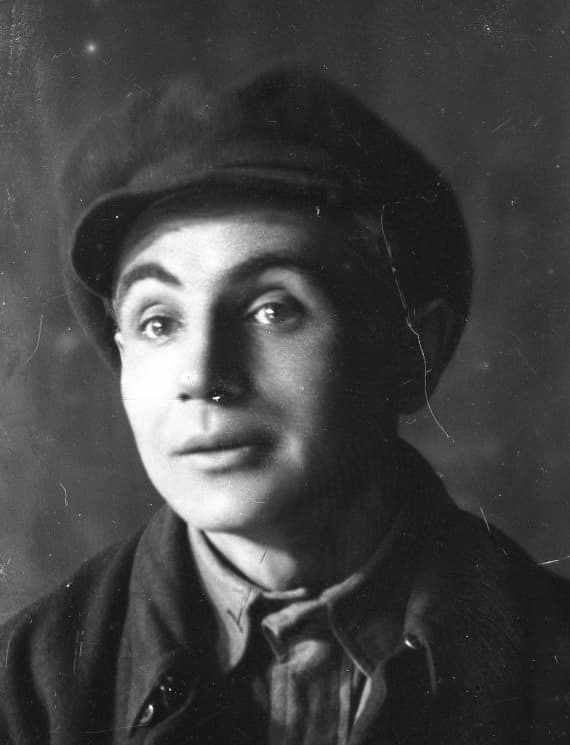Revue in 9 acts
Satire Pamphlet: Volodymyr Yaroshenko
Interludes: Yevhen Kaplia-Yavorovskyi, Serhii Bondarchuk
Composition: Yanuarii Bortnyk
Premiere: March 19, 1926
Director: Yanuarii Bortnyk
Members of Director’s Lab: Hanna Behicheva, Yukhym Lishanskyi
Choreographer: Yevhen Vihiliov
Artists: Valentyn Shkliaiv, Maiia Symashkevych, Vasyl Kryzhanivskyi
Composer: Semen Tartakovskyi
Stage Director: Oleksandr Savytskyi
Cast
Stryzhak – Stepan Shahaida, Kost Koshevskyi
Accountant – Marian Krushelnytskyi
Dovhal – Les Serdiuk, Fedir Radchuk
Olka the Typist – Valentyna Chystiakova, Hanna Babiivna
Shershepka – Fedir Radchuk, Petro Masokha
Поетеса — Антоніна Смерека
Peasant – Demyd Babenko
Worker – Vasyl Stetsenko
Secretary of People’s Court – Mykola Savchenko
Beer Hall Owner – Serhii Karpenko
Prostitutes – Iryna Steshenko, Lidiia Krynytska
Homeless – Lesia Datsenko, Olha Pihulovych
Beer Hall Musicians – Stanislavska, Andrii Shutenko, Serhii Khodkevych
Search Agents – Borys Balaban, Serhii Karpenko
Police – Mytrofan Kononenko, Hryhorii Kozachenko, Vasyl Stetsenko
Death Dance – Nadiia Tytarenko, Borys Balaban, Petro Masokha
Aristocrats, Workers, Jesters, Disputants
The whole troupe performed in the show.
The plot of Riff-Raff unfolds in a private handicraft industry organization (Kustprom) during NEP. The expectation of an audit by the Central Handicraft Industry Organization creates tension, as the organization has been run dishonestly. Aside from financial misconduct, bloated bureaucracy and nepotism, there is also a comic love triangle: the accountant is in love with the typist, Olka, who is cheating on her husband with Kustprom deputy head Stryzhak. The members of the organization decide that Olka should seduce the accountant so that she can steal the documents related to the deputy manager’s expenses and frame the manager. But the scheme doesn’t work out and in the end all the employees are arrested.
The plot is broken up by three interludes that expand the circle of “riff-raff” – opportunists, pseudo-intelligentsia, moral twisters – who, in the opinion of the authors, are preventing the building of socialism. The first interlude “A dispute about marriage, love and family” is a continuation of the theme of secretary Olka’s betrayal. Episodic characters (anarchist individualist Kirpichikov, Archbishop Sharovarnikov, young Molokososenko) recite comic monologues and reflect on the problems of civil marriages, the alimony system and monogamy. The second interlude “Revolutionary foxtrot play” is a parody of Anatoly Lunacharsky’s Arsonists. The third interlude “Jour fixe on a bourgeois stove” pokes fun at spending time in a café talking about the “horrors” of Ukrainization and new proletariat art, and ends with a spiritual séance where they summon Shevchenko and Lenin.
This directorial debut of Yanuarii Bortnyk, a graduate of the Berezil Artistic Association Director’s Laboratory, was reminiscent of the circus music hall (revue) genre that was popular in Europe. The stage looked like a skating rink (a plywood floor with yellow and black chessboard squares). Jesters skated around and introduced the characters, changed the scenery, commented on the acts, and participated in the interludes. Above the stage there was a sign that read “Menagerie”(a circus animal cage). The actors wore animal masks: Stryzhak was a boar, secretary Olka was a monkey, the accountant was a badger, Dovhal was a bear. The satirical depiction of negative characters in theater in the 1920s was often based on morphology, such as in the plays That’s how Huska (goose) Died by M. Kulish, Patsiuk (rats) Family by A. Hak, Tsvirkuny (crickets) by Y. Bedzyk, Pavuk (spider) in the Collective Farm by I. Kocherha, among others. Riff-Raff required that the performers have acrobatic and clown skills and motivated the theater collective to continue training and improving their technique.
The show was very popular. O. Aleksandrov also staged the play at the Taras Shevchenko Theater, but it didn’t make such a splash. Critics at the time noted the technique of the theater, which was working on a new type of show, but had mixed opinions about the level of performance. Yurii Smolych complained in New Art about the discreteness of the plot, that the theme was stale with newspaper feuilletons, the dramatic material wasn’t funny and felt the interludes slowed down the action. However, P. Rulin and Kh. Tokar appreciated Riff-Raff’s young director’s attempt to create a satirical show and applauded the actors for their skills and ability to transform into grotesque images.

